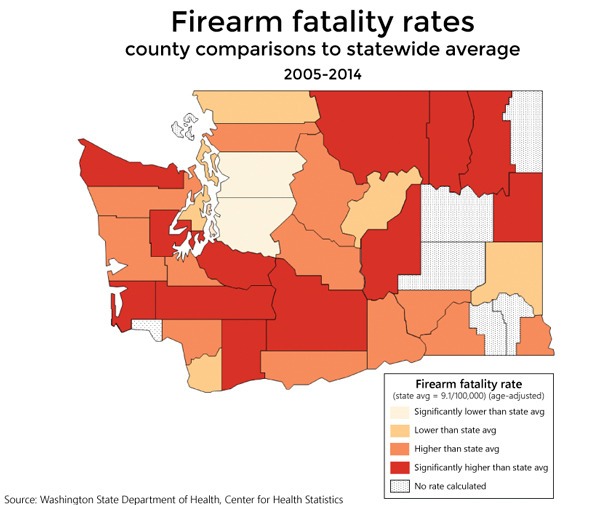OLYMPIA—An executive order issued Jan. 6 by Gov. Jay Inslee intends to reduce suicides in the state by first analyzing data and laws concerning gun violence.
The order takes a public-health approach to gun violence—an approach also used to prevent vehicular fatalities, which have steadily dropped since implementation of the state plan Target Zero.
Between 2012 to 2014, 665 people died by firearms in Washington. Of those firearm fatalities, 520 were suicide, according to data from the Washington State Department of Health.
Suicides are by “people who had a moment of depression. Who, if we can get them through it, can have a useful life,” Inslee said. “That’s a good thing and it shouldn’t be controversial.”
The governor’s order came the same day the Washington State Department of Health released the Washington State Suicide Prevention Plan. The order also came one day after President Obama issued an executive action to curb gun violence, a plan that included more funding for mental-health treatment and more encompassing background checks for gun sales.
The governor’s order lists four actions, including a mandate to collect, review and disseminate more data about gun violence, and to find gaps between laws and law enforcement in gun crimes. The order calls for the implementation of the Washington State Suicide Prevention Plan, which was ordered but not enacted by legislation in 2014. In addition, the attorney general must update a 2007 review of state and federal laws on gun possession.
The suicide prevention plan mentioned a coalition established in Wenatchee following 30 suicides in Chelan and Douglas counties during 2012. An organized effort to raise awareness about suicide and train people to recognize suicidal symptoms resulted in a decrease to eight suicides in both counties during 2014.

Nineteen of 39 counties in Washington have rates of suicide higher than the state average, the plan cites. Many of these counties are in rural and semi-rural areas and include Skamania, Grays Harbor, Clallam, Okanogan, Stevens, Pierce, Jefferson, Mason, Thurston, Pacific, Cowlitz, Clark, Skagit, Chelan, Kittitas, Klickitat, Walla Walla, Asotin, and Spokane.
According to data included in the plan, males 65 years and older have the highest rate of suicide. Suicide also disproportionately affects people in areas of poverty, American Indians and veterans, the plan states.
Numerous organizations and state departments are tasked with completing the work cited in the order, including the Department of Health, Department of Social and Health Services, Office of Financial Management and the attorney general’s office.
The Washington State Suicide Prevention Plan aggregated data and recommendations from a variety of state and federal agencies. The governor’s executive order allows these recommendations to be enacted in an effort to reduce suicide in the state.
“Suicide is inextricably tied to firearms,” said Karyn Brownson, project manager for the suicide prevention plan. “The real strength of this plan is that it calls on everyone to play a role in suicide prevention by having some coordinated movement and talking to each other.”
According to Steve Saxe, director of community health systems at the Department of Health, the order should help the identification and dissemination of more specific data about suicide and firearms. Two examples of this kind of data, provided in the plan, are sexual orientation and gender identity.
“Frankly, the things we propose are modest,” Inslee said. “I’ve offered a hand to seek bipartisan successes dealing with gun violence. I’ve taken years to do that and the sad fact is we have not been able to fashion a bipartisan response.”
House Speaker Frank Chopp, D-Seattle, and Senate Democratic Minority Leader Sen. Sharon Nelson, D-Maury Island, support Inslee’s executive order. Republican leaders said an executive order is unnecessary.
House Minority Leader Rep. Dan Kristiansen, R-Snohomish, whose family suffered a death from gun violence, said many gun-control laws already exist, but the laws are not being enforced. Criminals will ignore the law anyway, he added, and believes mental illness is an important factor to consider when studying gun control.
Senate Majority leader Sen. Mark Schoesler, R-Ritzville, said that if the plan was “common sense” then the governor should have brought a bill to the Legislature.
The National Rifle Association supports legislative action that mitigates the mental-health crisis, according to Lars Dalseide, a public affairs media liaison for the NRA.
“If they arrest and prosecute those who break the law and start properly treating the mentally ill then maybe Governor Inslee can begin focusing on the real problems facing law-abiding Washingtonians today,” Dalseide wrote in an email.
The National Suicide Prevention Lifeline is available by phone at 800-273-8255 or text at 741741. The line is open 24 hours a day. Local hotlines may be found at http://www.suicide.org/hotlines/washington-suicide-hotlines.html
Further information related to indicator signs for a potential suicide is available at http://www.suicidology.org/resources/warning-signs


